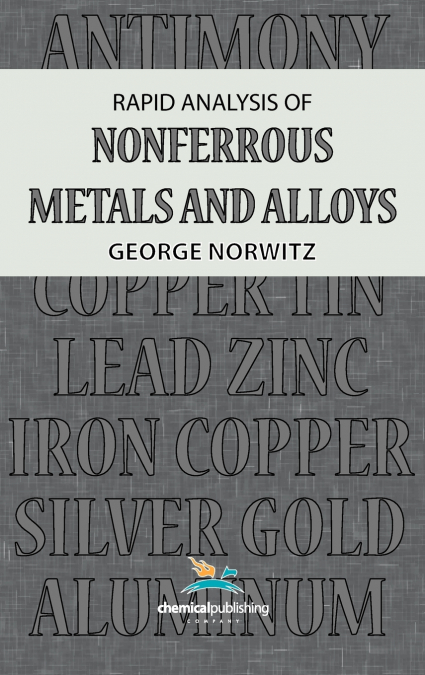
George Norwitz
CONTENTS - 1. SPECIAL REAGENTS - 2. INGOT COPPER - Copper; Lead and Iron; Bismuth; Antimonyand Arsenic; Sulfur - 3. BRASSES AND BRONZES - Sequence Procedure for Copper, Lead, Tin,Nickel, and Iron in Brasses and Bronzes withLess than 0.3% Iron and No Manganese;Zinc; Phosphorus; Antimony; Sulfur; SequenceProcedure for Copper, Lead, Tin,Manganese, Nickel, Iron, and Aluminum inManganese Bronzes; Zinc; Sequence Procedurefor Copper, Lead, Tin, Manganese,Iron, and Aluminum in Copper-Nickel Alloys;Nickel; Zinc; Sequence Procedure forCopper, Lead, Iron, Nickel, and Manganesein Silicon Bronzes; Silicon and Tin; Aluminum;Phosphorus; Zinc; Sequence Procedurefor Copper, Lead, Tin, Manganese,Nickel, and Iron in Copper-Beryllium Alloys;Cobalt; Silicon and Beryllium; SequenceProcedure for Copper, Lead, Iron, Nickel,Manganese, and Zinc in Copper-ArsenicAlloys; Aluminum; Silicon and Tin; Phosphorus;Arsenic - 4. MONEL METAL AND NICKEL METAL - Sequence Procedure for Silicon, Copper,Manganese, Iron, Aluminum, and Cobalt;Sulfur; Chromium; Titanium - 5. ALUMINUM ALLOYS -Sequence Procedure for Copper, Lead, Manganese,Iron, and Nickel; Copper in SeparateSample; Iron in Separate Sample; Zinc;Silicon; Magnesium; Titanium; Chromium;Tin; Copper, Lead, and Bismuth - 6. MAGNESIUM ALLOYS -Aluminum by the Succinate Method; AluminumColorimetrically; Zinc (over 1.5%)Electrolytically; Zinc (Less than 1.5%) byH28-ZnO Method; Sequence Procedure forCopper, Iron, and Nickel; Silicon; Manganese; Tin - 7. ZINC METAL (SPELTER) - Sequence Procedure for Tin, Copper, Lead,Iron, and Aluminum; Cadmium - 8. ZINC-BASE DIE-CASTING ALLOYS - Sequence Procedure for Tin, Copper, Lead,and Iron; Cadmium; Aluminum Colorimetrically;Aluminum and Magnesium byMercury-Cathode Method - 9. CADMIUM METAL -Cadmium; Sequence Procedure for Tin, Lead,Iron, and Aluminum; Sequence Procedurefor Silver, Copper, and Bismuth; Arsenicand Antimony; Zinc - 10. TIN METAL - Sequence Procedure for Bismuth, Copper,Lead, Iron and Zinc; Antimony; Arsenic - 11. LEAD METAL -Sequence Procedure for Tin, Silver, Iron,Bismuth and Copper; Antimony and Arsenic;Zinc - 12. LEAD-BASE BEARING METAL - Lead; Tin; Antimony; Arsenic; Copper;Bismuth; Iron - 13. TIN-BASE BEARING METAL -Tin; Antimony; Arsenic; Lead; Copper;Bismuth; Iron - 14. LEAD-TIN SOLDERS - Determination of Flux (Rosin Core); Determinationof Flux (Zinc Chloride Core);Lead; Tin; Antimony; Arsenic; Copper;Bismuth; Iron - 15. SILVER SOLDERS -Sequence Procedure for Silver, Copper, Cadmiumand Zinc; Sequence Procedure for Tin,Lead, Iron, and Nickel - 16. FUSIBLE BISMUTH ALLOYS -Sequence Procedure for Bismuth, Lead, and Cadmium - Index -